Plot summary
The year is 1586 and 35-year-old Sir Nicholas Beauvallet (great-great-great-grandson of Simon the Coldheart) - 'El Beauvallet' to the Spanish and called 'Mad Nick' by his men - is one of the most daring pirates of the Elizabethan era. With the blessing of the Queen, this friend and former associate of Sir Walter Raleigh sails the seas in his ship The Venture with the intention of plundering any Spanish ships that come his way. It is while engaged in one such enterprise that he takes the galleon on which the retired and ailing Governor Don Manuel de Rada y Sylva is returning home, accompanied by his daughter Dominica. Having plundered their own ship, Beauvallet promises to take them with him the rest of the way to Spain.
Doña Dominica's haughty spirit appeals to Beauvallet and he vows to come back to claim her within the year. Upon landing in England, he rides on a visit to his elder brother Gerard who, lacking heirs himself, reminds Nicholas that it is his duty to continue the family line. Three months later, Sir Nicholas visits a relation in France and then rides south towards the Spanish border, accompanied by his servant Joshua. There he meets the young Chevalier Claude de Guise, on a mission to deliver a secret message to the Spanish King. On catching the Chevalier trying to steal his horse, Beauvallet kills him in a sword fight and assumes his identity.
Travelling as a Frenchman provides Beauvallet with a convenient disguise in a rigidly Catholic land where the English are abhorred as Protestant heretics. Having arrived in Madrid, he learns that Dominica's father has died and that she is now under the protection of her uncle, Don Rodriguez. But even as he makes contact with Dominica's new family, Beauvallet arouses the suspicion of the French ambassador, M. de Lauvinière, who makes enquiries about him. Henceforward Sir Nicholas must engineer his escape with his chosen bride while avoiding the clutch of the Inquisition, or imprisonment as a spy, and the jealous intrigues of Dominica's other suitors.
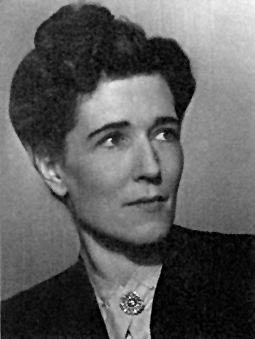
Georgette Heyer was an English novelist and short-story writer, in both the Regency romance and detective fiction genres. Her writing career began in 1921, when she turned a story conceived for her ailing younger brother into the novel The Black Moth. In 1925 Heyer married George Ronald Rougier, a mining engineer. The couple spent several years living in Tanganyika Territory and Macedonia before returning to England in 1929. After her novel These Old Shades became popular despite its release during the General Strike, Heyer determined that publicity was not necessary for good sales. For the rest of her life she refused to grant interviews, telling a friend: "My private life concerns no one but myself and my family."

These Old Shades is a 1926 historical romance written by British novelist Georgette Heyer. The novel is set around 1755: Heyer refers to the Duke of Avon's participation in the 1745 uprising as ten years previous; in addition the Prince of Condé is said to be about 20 years old. However, she also refers to Madame de Pompadour as actively involved with Louis XV, whereas her relationship with the King ended at about 1750.
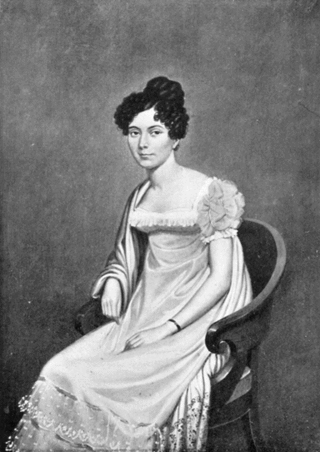
Juana María de los Dolores de León, Lady Smith, was the wife of General Sir Harry Smith, Governor of the Cape Colony.
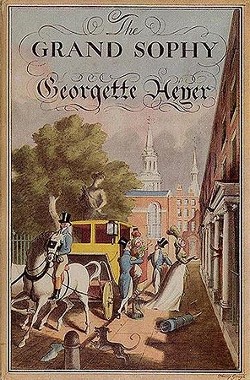
The Grand Sophy is a Regency romance novel by Georgette Heyer. It was first published in 1950 by Heinemann in the UK and Putnam in the U.S. Sales were brisk. Heinemann reported that in Australia it sold forty thousand copies in its first five months. There was also a Book Club edition in 1951.

The Foundling is a Regency romance novel written by Georgette Heyer and published by William Heinemann Ltd in 1948. It was also serialised in the Woman's Journal as "His Grace, the Duke of Sale", followed by a Book Club edition in 1949.

Cotillion is Georgette Heyer's twelfth regency romance, published in the UK in January 1953 by Heinemann and in the U.S. in February 1953 by G. P. Putnam's Sons. '

The Quiet Gentleman is a Regency novel by Georgette Heyer, published at the start of 1951 by William Heinemann Ltd. Set in the spring of 1816, after the Battle of Waterloo, it is the story of the return home from the wars of the Seventh Earl of St Erth to claim his inheritance. The novel incorporates elements of the mystery story as well as the classic romance.

April Lady is a Regency romance by Georgette Heyer, published in 1957 by Heinemann in the UK and by Putnam in the US. Previously serialised in the Woman's Journal as “My Lady Cardross”, the new novel was Heyer’s forty-fourth book and her fifteenth Regency novel.
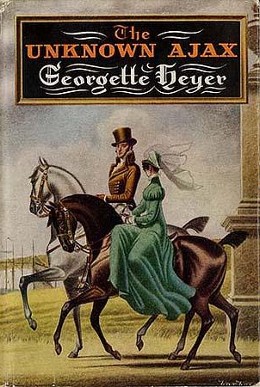
The Unknown Ajax is a Regency romance by Georgette Heyer, published in 1959 by Heinemann in the UK and in 1960 by Putnam in the US. It was her forty-seventh novel and the eighteenth set in Regency times.

The Black Moth (1921) is a Georgian era romance novel by the British author Georgette Heyer, set around 1751. The Black Moth was Heyer's debut novel, published when Heyer was nineteen. It was a commercial success.
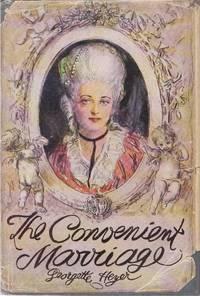
The Convenient Marriage is a Georgian romance novel by Georgette Heyer published in 1934. The novel is set in 1776 and concerns the relationship between Horatia Winwood and Lord Marcus Drelincourt. It is the first of several Heyer romances where the hero and heroine are married early in the novel, and the plot follows their path to mutual love and understanding. Later examples include Friday's Child and April Lady.

The Spanish Bride is a historical novel by Georgette Heyer based on the true story of Sir Harry Smith and his wife Juana María de los Dolores de León Smith. He had a fairly illustrious military career and was made a baronet. The town of Ladysmith in South Africa is named after his wife.

Faro's Daughter is a Georgian romance novel by Georgette Heyer that was first published in 1941 by Heinemann in the UK and in the US by Doubleday in 1942. The story's focus is on the misfortunes of an aunt and niece trying to run a gambling house for the upper classes.

The Reluctant Widow is a 1946 Regency romance by Georgette Heyer, published by Heinemann in the UK, and by Putnam the following year in the US. A humorous parody of a Gothic novel, it is set in early 1813. It was published with the description "By midnight she is a bride, by dawn a widow", and with gouache artwork by Philip Gough.

Lady of Quality is the final Regency romance written by Georgette Heyer. Published in the UK by The Bodley Head in 1972, and by E. P. Dutton in the U. S., it was the last of her novels to be published during her lifetime.

False Colours is a Regency romance by Georgette Heyer, published in 1963 in the UK by The Bodley Head and in 1964 by E. P. Dutton in the US. The novel is set in 1817, and concerns a young man who must temporarily impersonate his missing twin brother and the complications brought in the wake of this deceit. In British English, the term 'under false colours' refers to the use of a flag to which one is not entitled as a tactic for purposes of deception, and so by extension to any dishonest manoeuver.

A Civil Contract is a Regency era novel by Georgette Heyer, first published in October 1961 by Heinemann in the UK and in January 1962 by G. P. Putnam's Sons in the US. Set between 1814–1815, the story centres on a bankrupted viscount who reluctantly enters a marriage of convenience with a wealthy merchant's daughter. In this case the time is supported by a rich assortment of period detail.
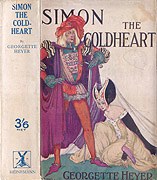
Simon the Coldheart is a historical fiction novel by Georgette Heyer published in 1925. Not a typical Georgie Heyer regency story, it is a tale of chivalry, intrigue and conquest. Set in the medieval period during the Hundred Years' War between England and France, it is her fifth novel, and the first of only three set in that period.
Kathleen Mary Lindsay (1903-1973), was an English writer of historical romance novels. For some years she held the record as the most prolific novelist in history. According to Guinness World Records, she wrote 904 books under eleven pen names. This record has since been surpassed.
Jennifer Kloester is an Australian-born writer, particularly known for her work on Georgette Heyer.


















